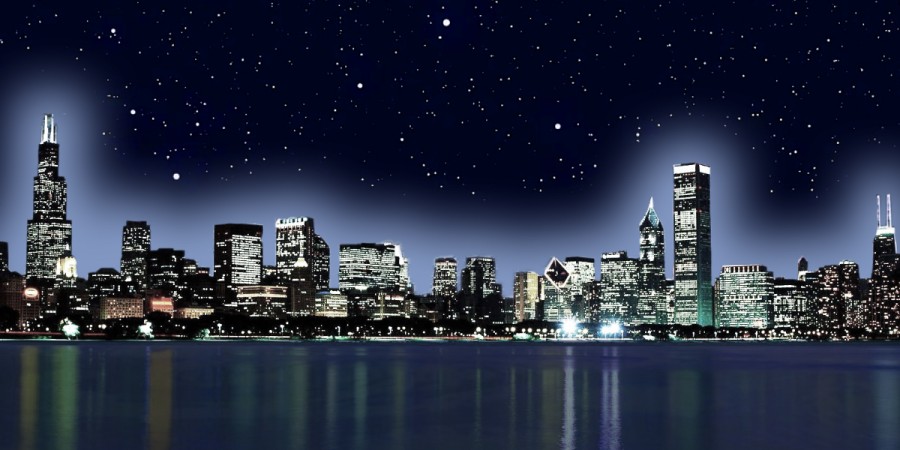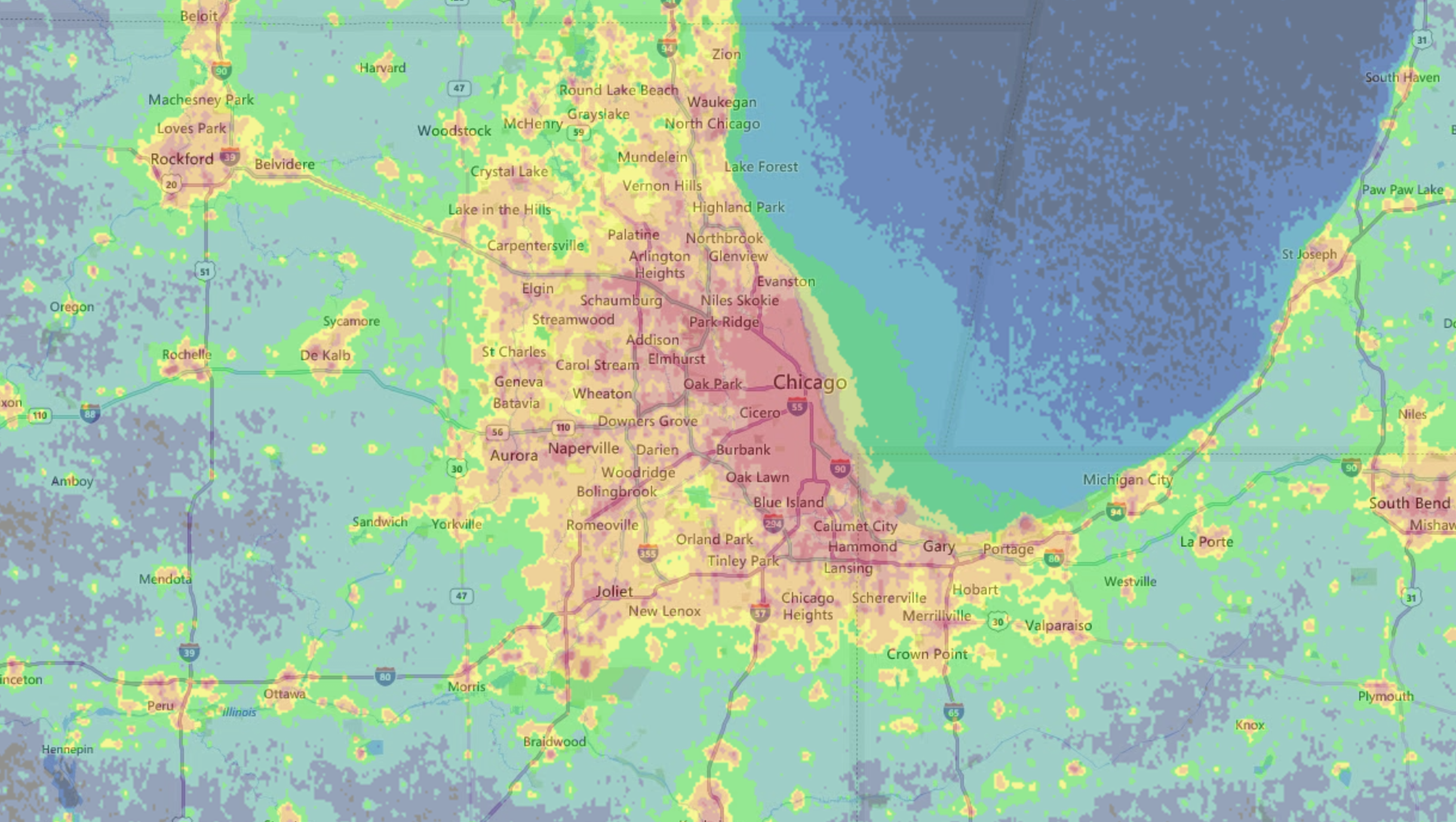Seeing Blue: Will Chicago’s New LED Streetlights Do More Harm Than Good?
By Monica Eng

Seeing Blue: Will Chicago’s New LED Streetlights Do More Harm Than Good?
By Monica EngChicago sixth-grader JJ Nnawuchi loves looking at the stars, but this little stargazer has to go to Indiana to get a decent view of the night sky. And he’s worried the situation will only get worse if the city continues to install its new, bright white LED streetlights.
“I’m kind of frustrated and sad, because Chicago is already one of the most light polluted cities in the world,” he says.
JJ was so concerned about the city’s growing use of LED lights that he did what any kid would do: He called Mayor Rahm Emanuel.
“I kept calling and calling, and his secretary said he wasn’t there,” he recalls. “Finally, I thought I was being a pest and was gonna stop, but my friend Audrey encouraged me to call one more time.”
That’s when the mayor answered the phone.
“We talked for 15 minutes, and I told him about light pollution and how the LEDs were bad and that he has the power to change light pollution in Chicago. … At the end, he said he would consider it.”
But JJ hasn’t heard anything back, so he reached out to Curious City and asked: Is this going to get better?
His question comes at a pivotal moment, when city officials are undertaking an ambitious four-year plan to use LEDs for about 80 percent of the city’s streetlights. They hope this plan will save the cash-strapped city $100 million over a decade and improve public safety. This summer, the city will charge forward with the next phase of the plan, which will ultimately replace 270,000 lights around the city by 2021.
But critics say this isn’t a bright idea — or maybe too bright of an idea? — and they point to a growing body of science showing links between some LED lights and health and environmental problems.
So we went to the city with a list of concerns that JJ has about the city’s use of LED lights. Here’s a rundown of those concerns, what experts say, and how the city responded.
1. Light pollution: Will I be able to see the stars in the sky?
What’s going on? Chicago has long been one of the most light polluted cities in the world, hampering citizens’ ability to see stars, according to some scientists. Over the past year, the city has been installing a type of LED light that it says will reduce overall light pollution. Those lights clock in at 3,000 Kelvin, which is the unit used to measure light temperature with higher numbers having more blue light. But critics say those lights give off too much blue light, which can worsen light pollution, and they want the city to use LED lights that are lowered to 2,200 Kelvin with a much more orange hue.

What do the experts say? Professor Martin Aube, a Canadian physicist and light pollution researcher, says the LED lights the city is installing now could actually slightly reduce light pollution compared to the older, non-LED lights they’re replacing. But he says using 2,200-Kelvin LED lights would reduce Chicago’s light pollution by “at least 50 percent” of current levels.
What’s the city going to do? The city has not said if it will pivot to 2,200-Kelvin lights, but an official said they’ve contacted at least one manufacturer that has developed a new 2,200-Kelvin streetlight. The manufacturer confirmed this with Curious City but asked to remain anonymous.
2. Can LED lights actually reduce crime?
What’s going on? If you haven’t read the news for the last couple of years, Chicago has a crime problem. Mayor Rahm Emanuel applauds the new LED lights because “you can brighten the lights to a very high level” in high crime areas, implying that brighter streets will lead to reduced crime. In fact, the city has prioritized installation in areas with higher public safety issues.

What do the experts say? Most studies show that brighter street lights either have no effect on crime or actually increase it. A 2000 study by the Illinois Criminal Justice Information Authority found that, after Chicago installed brighter lights in certain alleys, nighttime crime rose up to 24 percent in certain categories. But a 2017 study of New York City Housing projects showed 12 to 39 percent decreases in certain nighttime crimes when increased outdoor lighting was introduced.
What’s the city going to do? A spokesman for the city’s Department of Transportation, which oversees the LED light expansion, says the lights could help reduce crime by offering better clarity for police video cameras on the street. The spokesman also says the lights could improve traffic safety at night.
3. Are LED lights more energy efficient?
What’s going on? Since LEDs use a much lower wattage than the city’s old streetlights, they could use up to 50 percent less energy. The city estimates this will save taxpayers $100 million over 10 years once it replaces all 270,000 streetlights with LEDs.
What do the experts say? Scientists agree. LED lights are best for energy efficiency.
What’s the city going to do? City officials say they are leveraging the estimated $10 million a year in energy savings to help pay the $160 million bill for light replacement and management.
4. Can LED lights affect human health?
What’s going on? High Kelvin LEDs emit a lot of blue light, which has been shown to reduce people’s levels of melatonin — a hormone that helps regulate sleep and mitigate cancer. So critics worry that evening exposure to the lights (outside and through windows) could increase Chicagoans’ rates of cancer and sleep-related disorders, like depression and Type 2 diabetes.

What do the scientists say? The American Medical Association urges cities to keep blue light in their streetlights to a minimum to reduce harm to human health. A recent Spanish study specifically linked LED streetlight exposure to increases in breast and prostate cancer. This joined a 2017 Harvard study linking breast cancer to increased outdoor lighting. All this leads Tulane oncology professor Dr. David Blask to conclude there is “a strong case that outdoor lighting may contribute to [cancer] risk.”
Still, he and others acknowledge that no studies have conclusively singled out LED streetlights as the only factor. Mariana Figueiro, the director of the Lighting Research Center at the Rensselaer Polytechnic Institute in New York, says incidental blue light exposure to streetlights is likely a much less significant health factor than blue light emitted from devices (phones, etc.) inside the home at night.
One health issue few dispute is how the glare from high Kelvin LED lights can cause eye discomfort and reduced clarity for some people, especially those over 40. “This is due to the short visible wavelengths particularly in blue light,” says Karl Citek, a professor of optometry at Pacific University. “So I advise patients to try to avoid looking directly at or in the direction of the offending light.”
What does the city say? In a statement, the Chicago Department of Transportation said, “Exposure from outdoor street lighting has not been identified as a leading public health concern. These questions in the public health community have primarily centered on interior light sources within people’s homes, particularly with the increased use of cell phones, tablets, computers and TVs at night.”
5. Can LED lights affect wildlife?
What’s going on? Animals are conditioned to experience blue light only during the day. So when blue light is used at night, it messes with their behavior, populations, migration, mating, and daily cycles.

What do the scientists say? Numerous studies have shown changes to animals’ behavior when they are exposed to blue light at night. To minimize these effects, scientists advise using the lowest Kelvin lights possible. Dr. Thomas Davies at Bangor University in Wales says his studies show even more benefits from turning the lights off at night to reduce “unwanted ecological effects from LEDs.”
What does the city say? The city did not respond to questions on this subject.
More about our questioner

JJ Nnawuchi was born in Nigeria and attends Ida B. Wells Elementary School in Bronzeville. When he and his family moved to Chicago last year, he joined the Chicago Astronomical Society. There, he heard about the city’s plan to install LED lights, which he feared would make the night sky even brighter.
When we told JJ about that the city is at least considering a less blue LED light, he was ecstatic.
“That’s actually great news,” he says. “That light could actually be useful in reducing light pollution here. I think we are on the verge of stopping light pollution, but the only thing we can do now is cross our fingers.”
The 12-year-old has testified about light pollution at a Cook County Board meeting and corresponded with famed scientist Neil deGrasse Tyson on the matter.
JJ says when he grows up, he wants to be an astronautical engineer at NASA.
Monica Eng is a WBEZ reporter. Follow her at @monicaeng or write to her at meng@wbez.org.
